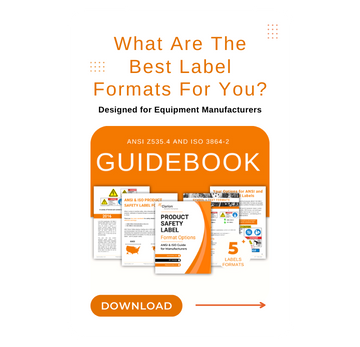The Link Between Labels and Liability
The main goals of your product safety labels are to:
- Make your product safe over its entire life cycle (its transportation, installation, use, service, decommissioning, and disposal).
- Enable compliance with your intended markets’ codes and regulations (such as WEEE/RoHS, UL®-compliance, or CE marking).
- To fulfill your “duty to warn.” This legal theory of liability asserts that, when you have reasonably foreseeable potential hazards associated with your products, you have a duty to warn people about those hazards so they aren’t injured or killed.
When it comes to the third item, your “duty to warn,” it’s important to note that two of the most common allegations found in liability lawsuits in the U.S. today are “inadequate warnings” and “failure to warn.” Both of these charges tie into the liability theory of a manufacturer’s duty to warn. Your company’s exposure to product liability lawsuits is directly linked to the warnings you place on your products – and those you choose not to place on your products. The choice you make in terms of both what you choose to warn about and how you decide to convey those messages is critical. The duty to warn is essential to cover any danger from the intended or unintended but foreseeable use of your products.
Common Labeling Mistakes
We frequently come across product manufacturers – across all different industries and responsible for many different types of machinery and equipment – who mistakenly believe their warnings are adequate, when in fact, they’re not up to today’s most current standards.
Typical mistakes that we see include:
- Issues with symbols – a lack of symbols, poorly drawn symbols, or symbols not formatted to the ISO standards.
- Issues with formats and color – outdated OSHA or ANSI standards, lack of consistency, or colors that fail to meet U.S. or international standards.
- Issues with label materials – inferior grade materials, the wrong material for the application, or labels that fail to be visible over the machine’s lifecycle.
- Issues with signal words and word messages – wrong signal words, presenting too much information, or failing to provide adequate information about the hazard.
- Issues with the approach/audience – a “wallpaper” of warnings, not taking your audience/their training into consideration, or lack of consistency across all areas of your safety program.
We're Here to Help
In practical terms, there are many decisions that need to be made when it comes to communicating safety effectively and fulfilling your company’s duty to warn. You should know that these decisions could be questioned in court should an accident occur and a lawsuit result; documenting your decisions will be important.
Amid the choice of whether or not to warn and what that warning should look like, remember: using the latest standards and best practices in product safety label design will help you to defend against allegations of “inadequate warnings.” Here at Clarion Safety, we can help to guide you in the direction of the key standards and best practices that are used to develop proper warnings – all in the effort to provide a means to clearly communicate safety-related information to help prevent injuries and save lives. In fact, because of our specialized expertise in this field, we are frequently called upon to lecture on various topics related to warnings at engineering, insurance, legal, and industry safety conferences.
For the best in product safety labels, you can either choose from our stock of best practice label designs, or contact our Customer Service Department staff to tailor customized safety labels to meet your specific needs.
